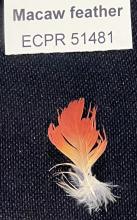cuezalin (Mdz37r)
This element has been carved from the compound glyph on folio 37 recto of the Codex Mendoza for the place name, Cuezallan. This principal component of the compound glyph consists of four long feathers of the red macaw. The four feathers are standing vertically. They have turquoise blue tips.
Stephanie Wood
To the Nahuas, these feathers symbolized flames and fire. Thelma Sullivan, cited in our dictionary (in the reference elsewhere in this record), noted that Cuezaltzin (with the reverential ending) was one of the names of Xiuhtecutli, "God of Fire." Alfredo López Austin has also noted that Cuezalin was the name of a deity associated with death. See Los mitos del tlacuache (1996), p. 194.
Stephanie Wood
c. 1541, but by 1553 at the latest
Stephanie Wood
cuizalin, cozalin, tail feathers, wing feathers, birds
This small macaw (cuezalin) feather was discovered in an Ancestral Puebloan community and is now housed in the Edge of the Cedars museum in Blanding, Utah. Such feathers were objects of long-distance trade between what is now the U.S. Southwest and Mesoamerica. (Photo by Stephanie Wood, 6 October 2023.)

cuezal(in), scarlet macaw wing or tail feathers, https://nahuatl.wired-humanities.org/content/cuezalin
red macaw tail and wing feathers
la cola y la plumas de las alas del guacamayo escarlata
Stephanie Wood
Codex Mendoza, folio 37 recto, https://digital.bodleian.ox.ac.uk/objects/2fea788e-2aa2-4f08-b6d9-648c00..., image 84 of 188.
The Bodleian Libraries, University of Oxford, hold the original manuscript, the MS. Arch. Selden. A. 1. This image is published here under the UK Creative Commons, “Attribution-NonCommercial-ShareAlike 3.0 License” (CC-BY-NC-SA 3.0).




